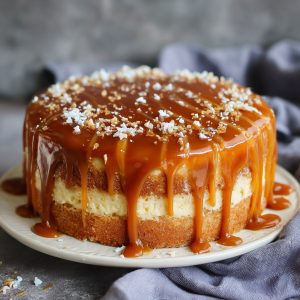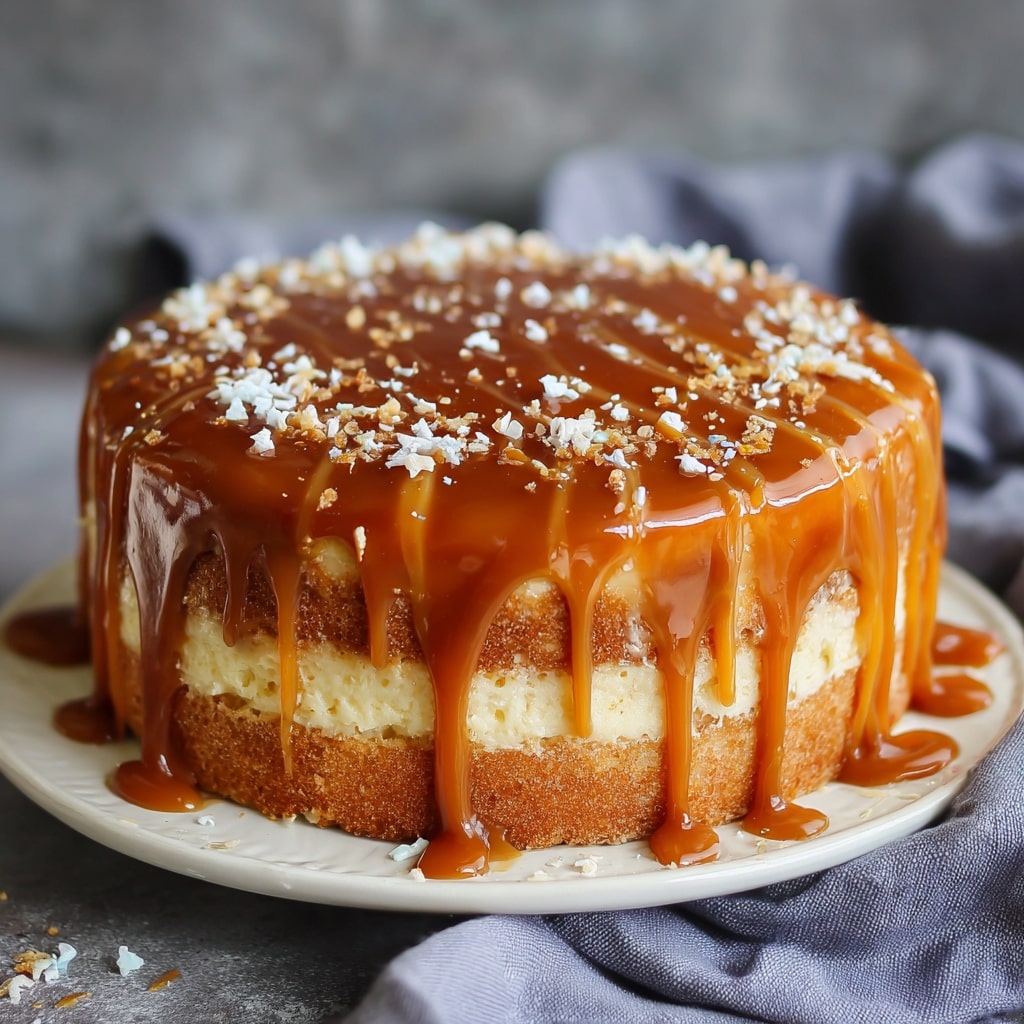The Vanilla Bean Caramel Cake is a luxurious dessert that captures the timeless elegance of classic vanilla paired with the deep, buttery richness of caramel, resulting in a cake that is both comforting and sophisticated. This cake celebrates the natural aroma of real vanilla beans, elevating the overall flavor profile with their floral, aromatic complexity while the caramel brings a velvety sweetness and a touch of indulgent warmth that balances beautifully with the light, fluffy sponge. Historically, vanilla cakes have been staples in European and American baking traditions for centuries, gaining particular popularity in the 19th century with the availability of pure vanilla extract and the later introduction of vanilla bean cultivation in tropical regions such as Madagascar and Tahiti. Caramel, originally a candy confection made by melting sugar, was first incorporated into desserts in France and gradually evolved into a versatile component used in sauces, fillings, and frostings—its pairing with vanilla became a classic in the early 20th century as layered celebration cakes grew in popularity.
The ingredients for this cake typically include all-purpose flour, baking powder, baking soda, salt, unsalted butter, granulated sugar, eggs, whole milk or buttermilk, vanilla bean paste or scraped vanilla pods, and for the caramel components, sugar, butter, heavy cream, and a pinch of sea salt to enhance the depth of flavor.
The step-by-step recipe begins with creaming the butter and sugar together until light and fluffy, then incorporating the eggs one at a time before adding the sifted dry ingredients alternately with milk to create a soft, moist vanilla cake batter enriched with vanilla bean paste for a fragrant finish. The cakes are baked until golden and springy, while a homemade caramel sauce is prepared by melting sugar until amber in color, then whisking in butter, warm cream, and salt to form a silky, golden drizzle. A light caramel buttercream frosting is whipped using softened butter, powdered sugar, a touch of caramel sauce, and more vanilla bean paste, offering a perfect balance of sweetness and creaminess. For flawless results, use room-temperature ingredients to ensure a smooth batter, avoid overmixing to keep the crumb tender, and chill the caramel slightly before using it to layer or decorate the cake to prevent it from becoming too runny. Variations of this cake can include the addition of chopped nuts such as pecans or hazelnuts for added texture, a salted caramel twist for a modern flavor contrast, or pairing it with whipped cream cheese frosting for a tangy counterpoint to the sweetness. Nutritionally, while this dessert is high in sugar and saturated fat, it can be enjoyed in moderation and adapted with reduced-sugar options or lightened-up frostings for those seeking a slightly healthier version, and real vanilla offers antioxidant properties when compared to synthetic extracts. Frequently asked questions often include whether vanilla extract can be substituted for vanilla bean paste (yes, though the flavor will be less intense), how to store the cake (in an airtight container at room temperature for 1-2 days or refrigerated for up to 5 days), and whether the caramel can be made ahead (yes, up to one week in advance if stored in the fridge and reheated gently).

Vanilla Bean Caramel Cake
Ingredients
Ingredients:
- 1½ cups granulated white sugar
- 12 tablespoons 1½ sticks unsalted butter, softened
- 3 large eggs at room temperature
- 3 teaspoons vanilla extract vanilla bean paste, or scraped vanilla bean (or a combination)
- 2¼ cups all-purpose flour
- 2½ teaspoons baking powder
- 1 teaspoon salt
- 1¼ cups whole milk
- 1 cup salted caramel sauce cooled
For the Frosting:
- 2 sticks 1 cup unsalted butter, softened
- 4 cups powdered sugar
- 2 tablespoons heavy cream or milk
Instructions
- Preheat your oven to 350°F (175°C). Grease and flour two 8-inch round cake pans, then line the bottoms with parchment paper and set aside. In a medium mixing bowl, cream together the butter and sugar until light and fluffy. Beat in the eggs one at a time, then continue mixing on high speed for about 3 minutes, until the mixture becomes pale and airy. Stir in the vanilla extract or paste. In a separate bowl, whisk together the flour, baking powder, and salt. Add the dry ingredients to the creamed mixture in three additions, alternating with the milk and beginning and ending with the dry mixture. Mix until just combined, being careful not to overbeat. Evenly divide the batter between the prepared pans and smooth the tops with the back of a spoon or spatula. Bake for 30 to 40 minutes, or until a toothpick inserted into the center comes out clean. Let the cakes cool in the pans for 5–10 minutes, then turn them out onto a wire rack to cool completely.
- For the frosting, beat the softened butter until smooth and fluffy. Gradually add the powdered sugar, one cup at a time, and mix until fully incorporated. Add ⅓ cup of the cooled caramel sauce and beat again until light and fluffy. If the frosting appears too thick, add 1 to 2 tablespoons of cream or milk to adjust the consistency.
- To assemble the cake, place one cake layer on a serving plate or cake stand. Use a fork to gently poke holes across the surface of the cake. Carefully pour about ⅓ cup of the caramel sauce over the top, allowing it to seep into the holes. Spread a thick layer of frosting over the caramel-soaked layer. Add the second cake layer on top, with the flattest side facing up. Repeat the process of poking holes, drizzling with the remaining caramel sauce, and spreading on the frosting. For an extra touch, sprinkle flaky sea salt over the top if desired.

